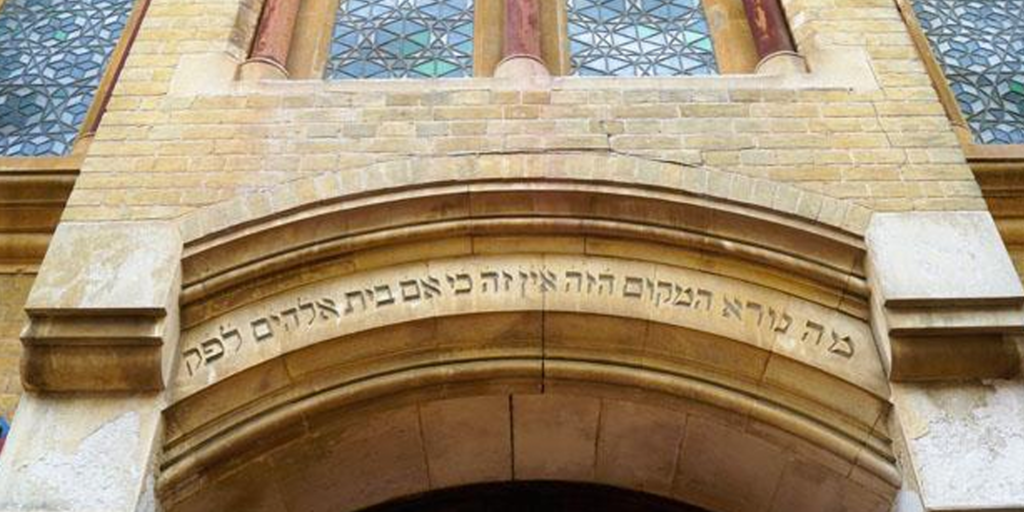
Facts and Trivia
Private tours with a local historian and educational tours for school parties can be booked. Click here to find out about our heritage days and events.
There are lots of nooks and crannies in Middle Street to explore. Here are a few of them. See if you can spot them all when you make your next visit!
Color scheme
Much of the original colour scheme and design work show the influence of the early Arts and Crafts movement and of designers such as William Morris. Take a second look again at all the electroliers in the main hall, the Ark enclosure railings and the “renaissance” design windows.
The colours of the original lobby matched the colour of the walls above the ark. The skirting board colour was a deep slate blue surmounted by a deed blood-red band. The walls were deep olive green shades with a deep red greek-motif stenciled design running around the room at the height of the dado rail. All this can still be seen where? In the cupboard under the stairs of course where no-one ever painted! These nature colors complimented the natural shades of the exquisite terracotta tiled lobby floor. The cast iron decorative stair banister rails are all glinting golden gold-leaf beneath the thick black paint they are covered over in today.
Lighting

Middle Street was originally lit by gaslight. It was changed to electricity from 1892. There are still some artifacts to be seen, however. Take a close look at the bottom of the staircase as you ascend to the first floor Ladies Gallery. The end pillar originally supported a bright gaslamp to illuminate the stairwell. You can still see the pipe connection running into the bottom of the pillar.
The Bima (Reading Desk Platform)
On the central reading desk platform (or bima) the four large torchiere lamps were originally gas-powered containing 30 jets at each corner. We still have the original cast-iron decorative flame fittings in our attic. To provide ventilation for the old gas-lit building the top central leaves of the large zodiac window hinge open sideways to allow excess heat out into the attic vestry room where there are large ventilating ducts through to the open air.
Prayer Books
There are a lot of old books in Middle Street that reflect the origins of the people came here over the years. The oldest prayer book we have found dates to 1805 and was printed in London. We have many other examples from throughout the 19th century which came from all over Europe and far beyond.
On a tour you can walk around the pews and read 19 biographies of noteable people connected with the community. 20 were planned but the 20th is yet to be written. The place is reserved for the person who, in the future, comes forward to ensure the future of the building for all future generations.
The Ark and Torah Scrolls

Today the Ark curtain opens sidewards, however, the original curtain went up and down in a theatrical fashion. We still have the last curtain to be operated in this manner and it dates back to the late 1920s.
The gates over the Ark were installed in 1915. The original gates were re-situated where they still remain to this day, They are the gates you walk through as you enter the main hall.
We have several scrolls all of which have different characteristics. Some are 19th-century and some are 20th. One is even an unusual Sephardic scroll as opposed to the more common Ashkenazic type.
The Warden’s Box

The railings of the warden’s box were donated as a fully brass copy of the regular style of railings. The ornate brass railings around the ark enclosure were added in the late 1880s.
Windows
The finest grade of glass is not to be found in the main hall stained glass windows ; it’s in the green and white geometric windows that cover the facade of the building.
Heating
Today the building is heated by a large boiler on the ground floor of the old schoolhouse behind the synagogue. Originally the boiler was sited in a small room beneath the rear courtyard. The chimney rises up the back of the building but it was built in such a manner that you’d never know it was there.
The Organ

The old organ was purchased in the 1930s to provide incidental music for weddings. It cost 12 shillings and sixpence at public auction. It dates from the very early 1900s. It is fitted with a very unusual pressure indicator. Like all instruments of its type, the organ operates via suction as opposed to pressure. The more negative air pressure that is generated by the pedaling the further the indicator dial arrow rotates showing the attainable volume levels at that particular moment. It is still fully playable and in tune.
Prayer Services
Whilst the weekly services of Middle Street conformed to all the usual norms there are a few quirky traditions peculiar to Middle Street alone. These traditions originated from different congregations around the world some of whose members formed part of Middle Street’s congregation over the centuries and passed on the individual traditions of the communities from where they originated.
Metalwork
All the metalwork floral and botanical designs on the railings were added in the 1880s to beautify the original black railings. Originally all the railings were black. The metalwork additions were all a fine golden high-polished lacquered brass. It remained thus until 1963 when a bad misguided management decision caused all the side railings have been overpainted white and the brass overpainted with gold paint. The building was given it’s grade listing several years later to protect it!
Like all the others in the immediate vicinity, this building is built on beach shingle. The water table is only 30 feet below the floor of the building.
Crack in the building
There has been a crack running through the building since 1899. If you look up at the zodiac window you can see it. In order to build the pub across the road mechanical pile-drivers were used to force the foundations into the shingle below. The constant mechanical pounding across the road caused the crack. It was all taken care of by the insurance policy at the time.
Internal Decorations
Much of the windows and internal decorations were originally executed by Campbell Smith & Co (founded 1873). Amazingly the company is still in existence today in Fleet, Hampshire and they still undertake high-class projects of this nature. Unfortunately, no records from their early years survive – they donated all their old papers during WWII towards a paper-recycling initiative!

Some of the seats pre-date the synagogue and came from the previous building in Devonshire Place in Brighton.
All of the wall pillars were originally painted to look like stone. They were painted alternately to be malachite green and porphyry red-orange. You can still see the original colour scheme at the roof-height level.
The floor of the Ladies Gallery still has its original linoleum. The painted wall designs above the Ark are also made of linoleum: lincrusta
